ORIGINAL SHELL COLOURATION
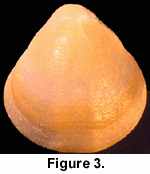 While
collecting the brachiopods it became clear that all of the relatively restricted
range of taxa present at this locality displayed undoubted preservation of
original colouration. The orange-red colouration of Calloria inconspicua
(Figures 3, 4,
5) and of the single specimen of Terebratella
sanguinea discovered (Figure 6) was
particularly distinctive, but the other brachiopod present in some abundance,
the rhynchonellid Notosaria nigricans, also displayed preservation of its
less obvious black to brownish colouration.
While
collecting the brachiopods it became clear that all of the relatively restricted
range of taxa present at this locality displayed undoubted preservation of
original colouration. The orange-red colouration of Calloria inconspicua
(Figures 3, 4,
5) and of the single specimen of Terebratella
sanguinea discovered (Figure 6) was
particularly distinctive, but the other brachiopod present in some abundance,
the rhynchonellid Notosaria nigricans, also displayed preservation of its
less obvious black to brownish colouration.  Other
molluscan taxa displayed original shell colouration (Figure
7), indicating that fossilisation and diagenetic conditions have favoured
the survival of colour pigments at this locality.
Other
molluscan taxa displayed original shell colouration (Figure
7), indicating that fossilisation and diagenetic conditions have favoured
the survival of colour pigments at this locality.
On the first day of collecting, the brachiopods
exposed on the surface of the fossiliferous layer were isolated from those
collected from within the sediment, and the state of colour preservation was
assessed separately. Although the method of assessment is subjective, depending
on a visual assessment under subdued lighting, it reinforced the impression that
developed during collection that the specimens exposed at the surface displayed
poorer colour preservation than those still entombed in sediment. 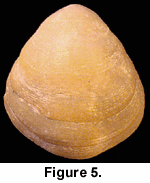 Of
the 54 complete or fragmented specimens of Calloria inconspicua that were
exposed at the surface of the sediment, a total of 36 (67%) had obvious signs of
colour preservation when washed of sediment. It was more difficult to assess the
colour survival in specimens of Notosaria nigricans, but a similar
exercise was attempted, and the results suggested that only 22% of specimens
exposed at the surface had preserved colouration (5 out of 23) as compared with
41% (17 out of 42) from within the sediment.
Of
the 54 complete or fragmented specimens of Calloria inconspicua that were
exposed at the surface of the sediment, a total of 36 (67%) had obvious signs of
colour preservation when washed of sediment. It was more difficult to assess the
colour survival in specimens of Notosaria nigricans, but a similar
exercise was attempted, and the results suggested that only 22% of specimens
exposed at the surface had preserved colouration (5 out of 23) as compared with
41% (17 out of 42) from within the sediment.
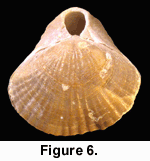 The
subsurface sampling at this locality yielded a total of 323 complete or partial
specimens of Calloria inconspicua, and 261 of these had obvious signs of
colouration (81%). The comparable data for Notosaria nigricans were 75
coloured specimens out of a total sample of 179 (42%). The specimens with the
strongest colour preservation were predominantly found underneath or at the side
of large pebbles, in crevices between pebbles, or inside large mollusc shells.
The implication is that these individuals were deposited, and fossilized, in
cryptic habitats. (Table 1, and Figures
8, 9).
The
subsurface sampling at this locality yielded a total of 323 complete or partial
specimens of Calloria inconspicua, and 261 of these had obvious signs of
colouration (81%). The comparable data for Notosaria nigricans were 75
coloured specimens out of a total sample of 179 (42%). The specimens with the
strongest colour preservation were predominantly found underneath or at the side
of large pebbles, in crevices between pebbles, or inside large mollusc shells.
The implication is that these individuals were deposited, and fossilized, in
cryptic habitats. (Table 1, and Figures
8, 9).
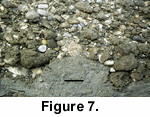 The
indications are that these brachiopods demonstrate the preservation of original
shell colouration, rather than post mortem mineralisation or ‘contamination’
of the sample by Recent specimens. The majority of specimens obtained were
collected from within the sediment in positions that rule out any possibility of
contamination by Recent specimens. Sessile, pedunculate brachiopods living on
this part of the coast since the deposition of the Rapanui sediments would not
have been able to penetrate the sediment because they are incapable of
burrowing.
The
indications are that these brachiopods demonstrate the preservation of original
shell colouration, rather than post mortem mineralisation or ‘contamination’
of the sample by Recent specimens. The majority of specimens obtained were
collected from within the sediment in positions that rule out any possibility of
contamination by Recent specimens. Sessile, pedunculate brachiopods living on
this part of the coast since the deposition of the Rapanui sediments would not
have been able to penetrate the sediment because they are incapable of
burrowing. 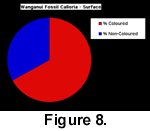 The
presence of coloured brachiopods more than 0.3 m beneath the sediment surface,
leaving clear imprints on the adjacent sediments, and the occurrence of other
specimens within the partially open valves of articulated bivalves, guarantees
that these are indigenous specimens.
The
presence of coloured brachiopods more than 0.3 m beneath the sediment surface,
leaving clear imprints on the adjacent sediments, and the occurrence of other
specimens within the partially open valves of articulated bivalves, guarantees
that these are indigenous specimens.
The fossils are much less strongly coloured than
living representatives of the species, the shells of which are a bright red
colour (Figure 10). 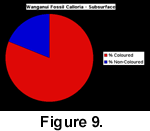 The
orange-red colour of the fossils indicates that partial decay of the molecule
responsible for shell colouration has occurred. In this species the red shell
colouration is a result of the presence of a red caroteno-protein that occurs
within the crystal of the shell (Curry
et al. 1991). As this molecule decays, its colour will change in much the
same way that rotten fruit or leaves pass through a variety of colour stages. An
amino acid analysis from the fossil shells demonstrated that partial molecular
decay had taken place when compared with an equivalent analysis from living
representatives of the species (Figure 11,
also includes description of the methodology used).
The
orange-red colour of the fossils indicates that partial decay of the molecule
responsible for shell colouration has occurred. In this species the red shell
colouration is a result of the presence of a red caroteno-protein that occurs
within the crystal of the shell (Curry
et al. 1991). As this molecule decays, its colour will change in much the
same way that rotten fruit or leaves pass through a variety of colour stages. An
amino acid analysis from the fossil shells demonstrated that partial molecular
decay had taken place when compared with an equivalent analysis from living
representatives of the species (Figure 11,
also includes description of the methodology used). 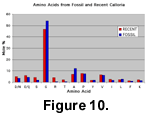 The
fossil shells are enriched in Glycine (G) and Alanine (A) relative to Recent
specimens, and this is expected as fossil shell are characterized by increases
in the proportions of these amino acids (because they are formed post-mortem
by the decay of less stable amino acids--Curry
et al. 1991).
The
fossil shells are enriched in Glycine (G) and Alanine (A) relative to Recent
specimens, and this is expected as fossil shell are characterized by increases
in the proportions of these amino acids (because they are formed post-mortem
by the decay of less stable amino acids--Curry
et al. 1991). 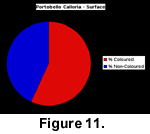 The
fossils do display a range of colour intensities and hues, suggesting that
variable decay of the carotenoid part of the molecule has also taken place. This
range of colours present in the fossils is similar to those in living shells,
and there is no indication of post-mortem staining by iron-rich solutions that
is known to occur in other brachiopods (Zenger
1967).
The
fossils do display a range of colour intensities and hues, suggesting that
variable decay of the carotenoid part of the molecule has also taken place. This
range of colours present in the fossils is similar to those in living shells,
and there is no indication of post-mortem staining by iron-rich solutions that
is known to occur in other brachiopods (Zenger
1967).

 While
collecting the brachiopods it became clear that all of the relatively restricted
range of taxa present at this locality displayed undoubted preservation of
original colouration. The orange-red colouration of Calloria inconspicua
(Figures 3, 4,
5) and of the single specimen of Terebratella
sanguinea discovered (Figure 6) was
particularly distinctive, but the other brachiopod present in some abundance,
the rhynchonellid Notosaria nigricans, also displayed preservation of its
less obvious black to brownish colouration.
While
collecting the brachiopods it became clear that all of the relatively restricted
range of taxa present at this locality displayed undoubted preservation of
original colouration. The orange-red colouration of Calloria inconspicua
(Figures 3, 4,
5) and of the single specimen of Terebratella
sanguinea discovered (Figure 6) was
particularly distinctive, but the other brachiopod present in some abundance,
the rhynchonellid Notosaria nigricans, also displayed preservation of its
less obvious black to brownish colouration.  Other
molluscan taxa displayed original shell colouration (Figure
7), indicating that fossilisation and diagenetic conditions have favoured
the survival of colour pigments at this locality.
Other
molluscan taxa displayed original shell colouration (Figure
7), indicating that fossilisation and diagenetic conditions have favoured
the survival of colour pigments at this locality.





